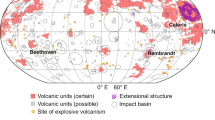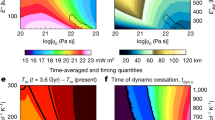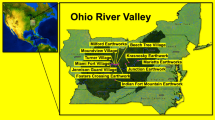Abstract
There is evidence that the Moon melted completely 4,400 Myr ago, and between 4,000 Myr and 3,200 Myr ago had an internal magnetic field. But gravity could not have provided the heat of melting, and it must have come from short lived radio elements. Theory suggests the transuranics with atomic numbers between 114 and 126 may be relatively stable, and it is shown that these ‘superheavy elements’ fit the requirements of the early heat source in the moon.
This is a preview of subscription content, access via your institution
Access options
Subscribe to this journal
Receive 51 print issues and online access
$199.00 per year
only $3.90 per issue
Buy this article
- Purchase on Springer Link
- Instant access to full article PDF
Prices may be subject to local taxes which are calculated during checkout
Similar content being viewed by others
References
Urey, H. C. The Planets, Their Origin and Development (Yale University Press New Haven, 1952).
Runcorn, S. K. Phil. Trans. 258, 228 (1965).
Sonnett, C. P., Colbourne, D. S. & Schwartz, K. Icarus 24, 231–255 (1975).
Reynolds, J. H. J. geophys. Res. 68, 2939–2956 (1963).
Brown, G. M., Eglinton, G., Runcorn, S. K. & Urey, H. C. (eds), The Moon: A New Appraisal from Space Experiments and Laboratory Analyses (The Royal Society, London, 1977).
Taylor, S. R. Lunar Science: A Post-Apollo View (Pergamon, Oxford, 1975).
Runcorn, S. K. et al. Proc. R. Soc. A 325, 157–174 (1971).
Collinson, D. W., Stephenson, A. & Runcorn, S. K. Phil. Trans. R. Soc. A 285, 241–247 (1977).
Rutherford, E., Chadwick, J. & Ellis, C. D. Radiations from radioactive substances (Cambridge University Press, Cambridge, 1950).
Gentry, R. V. Science 169, 670–673 (1970).
Gentry, R. V. et al. Phys. Rev. Lett. 37, 11–14 (1976).
Stephan, C., Epherry, M., Cieslak, E. & Sowinsky, M. Phys. Rev. Lett. 37, 1534–1536 (1976).
Jelley, N. et al. Nature 265, 35–36 (1977).
Ketelle, B. H., O'Kelley, G. D., Stoughten, R. W. & Halperin, J. Phys. Rev. Lett. 37, 1734–1737 (1976).
Sparks, C. J., Raman, S., Yakel, H. L., Gentry, R. V. & Krause, M. O. Phys. Rev. Lett. 38, 205–208 (1977).
Cahill, T. A. et al. Phys. Rev. (in the press).
von Wimmersperg, U. & Sellschop, J. P. F. Phys. Rev. Lett. 38, 886–888 (1977).
Hodgson, P. New Scient. 74, 706 (1977).
Larimer, J. W. & Anders, E. Science 175, 981–982 (1972).
Flynn, G. J. & Loubet, M. Nature 268, 717–718 (1977).
Wood, J. A., Dickey, J. S. Jr, Marvin, V. B. & Powell, B. N. Geochim. cosmochim. Acta Suppl. 1, 965–988 (1970).
Hubbard, N. J. & Minear, J. W. Geochim. cosmochim. Acta Suppl. 6, 1057–1085 (1975).
Papanastassiou, D. A. & Wasserburg, G. J. Geochim. cosmochim. Acta Suppl. 6, 1467–1490 (1975).
Lugmair, G. W., Scheinin, N. B. & Marti, K. Geochim. cosmochim. Acta Suppl. 1, 1419–1429 (1975).
Urey, H. C., Marti, K., Hawkins, J. W. & Lir, M. R. Geochim. cosmochim. Acta Suppl. 1, 965–988 (1971).
Runcorn, S. K. Geochim. cosmochim. Acta Suppl. 7, 3221–3228 (1976).
Sonett, C. P. & Duba, A. Nature 258, 118–121 (1975).
Nakamura, Y. et al. Geophys. Res. Lett. 1, 137–140 (1974).
Blackshear, W. T. & Capcynski, J. P. J. geophys. Res. 82, 1699–1701 (1977).
Runcorn, S. K. Proc. R. Soc. A 296, 270–284 (1967).
Coleman, P. J. & Russell, C. T. Phil. Trans. A 285, 489–506 (1977).
Russell, C. T., Coleman, P. J. & Schubert, G. Science 186, 825–826 (1974).
Runcorn, S. K. Phys. Earth Planet. Int. 10, 327–335 (1975).
Goldstein, B., Phillips, R. S. & Russell, C. T. Geophys. Res. Lett. 3, 289–292 (1976).
Sonnett, C. P. & Wiskerchen, M. J. Geochim. cosmochim. Acta Suppl. 8, (1977).
Tozer, D. C. The Origin of the Solar System (ed. Dermott, S.) (in the press).
Ransford, C. A. Lunar Science Abstracts VIII 793–794 (1977).
Lin, R., Anderson, K. A., Bush, R., McGuire, R. E. & McCoy, J. E. Geochim. cosmochim. Acta Suppl. 7, 2691–2703 (1976).
Stephenson, A., Collinson, D. W. & Runcorn, S. K. Geochim. cosmochim. Acta Suppl. 5, 2859–2871 (1974).
Runcorn, S. K. Geochim. cosmochim. Acta Suppl. 6, 2943–2953 (1975).
Backus, G. Proc. natn. Acad. Sci. U.S.A. 72, 1555–1558 (1975).
Gubbins, D. Geophys. J. 47, 19–39 (1976).
Runcorn, S. K. Science (in the press).
Ray, J. C. & Kohman, T. P. Canad. J. Phys. 35, 649–655 (1957).
Mizutani, H., Matsui, J. & Takeuchi, H. The Moon 4, 476–489 (1972).
Lee, T., Papanastassiou, D. A. & Wasserburg, G. J. geophys. Res. Lett. 3, 109–112 (1976).
Kaula, W. M. & Harris, A. Icarus 24, 516–524 (1975).
Runcorn, S. K. Geochim. cosmochim. Acta Suppl. 8, 463–469 (1977).
Lugmair, G. W. & Marti, K. Earth planet. Sci. Lett. 35, 273–284 (1977).
Enge, H. A. Introduction to Nuclear Physics 290 (Addison-Wesley, Reading, Mass. 1966).
Friedlander, G., Kennedy, J. W. & Miller, J. M. Nuclear and Radiochemistry 2nd ed. 229 (Wiley, New York, 1955).
Viola, V. E. Jr & Seaborg, G. T. J. inorg. Chem. 28, 741–761 (1966).
Nix, J. R. A. Rev. Nucl. Sci. 22, 65–120 (1972).
Fiset, E. O. & Nix, J. R. Nucl. Phys. A 193, 647–671 (1972).
Möller, P. & Nix, J. R. Phys. Rev. Lett. 37, 1461–1464 (1976).
Seaborg, G. T. & Bloom, J. L. Sci. Am. 220, 57–67 (1969).
Hodgson, P. New Scient. 75, 152–153 (1977).
Runcorn, S. K. & Coleman, P. J. Nature 265, 197–199 (1977).
Author information
Authors and Affiliations
Rights and permissions
About this article
Cite this article
Runcorn, S., Libby, L. & Libby, W. Primaeval melting of the Moon. Nature 270, 676–681 (1977). https://doi.org/10.1038/270676a0
Received:
Accepted:
Published:
Issue Date:
DOI: https://doi.org/10.1038/270676a0
This article is cited by
-
Magnetism of the Moon - a lunar core dynamo or impact magnetization?
Surveys in Geophysics (1993)
-
Palaeomagnetic data suggest link between the Archaean–Proterozoic boundary and inner-core nucleation
Nature (1987)
-
Lunar magnetism, polar displacements and primeval satellites in the Earth–Moon system
Nature (1983)
-
A search for evidence of superheavy-element fission in chondritic metal
Nature (1982)
-
Superheavy-element fission tracks in iron meteorites
Nature (1980)
Comments
By submitting a comment you agree to abide by our Terms and Community Guidelines. If you find something abusive or that does not comply with our terms or guidelines please flag it as inappropriate.



